A Book Full of Seaweed
Posted on Sun., April 1, 2018 by
Algology preserves a passionate engagement with the underwater world
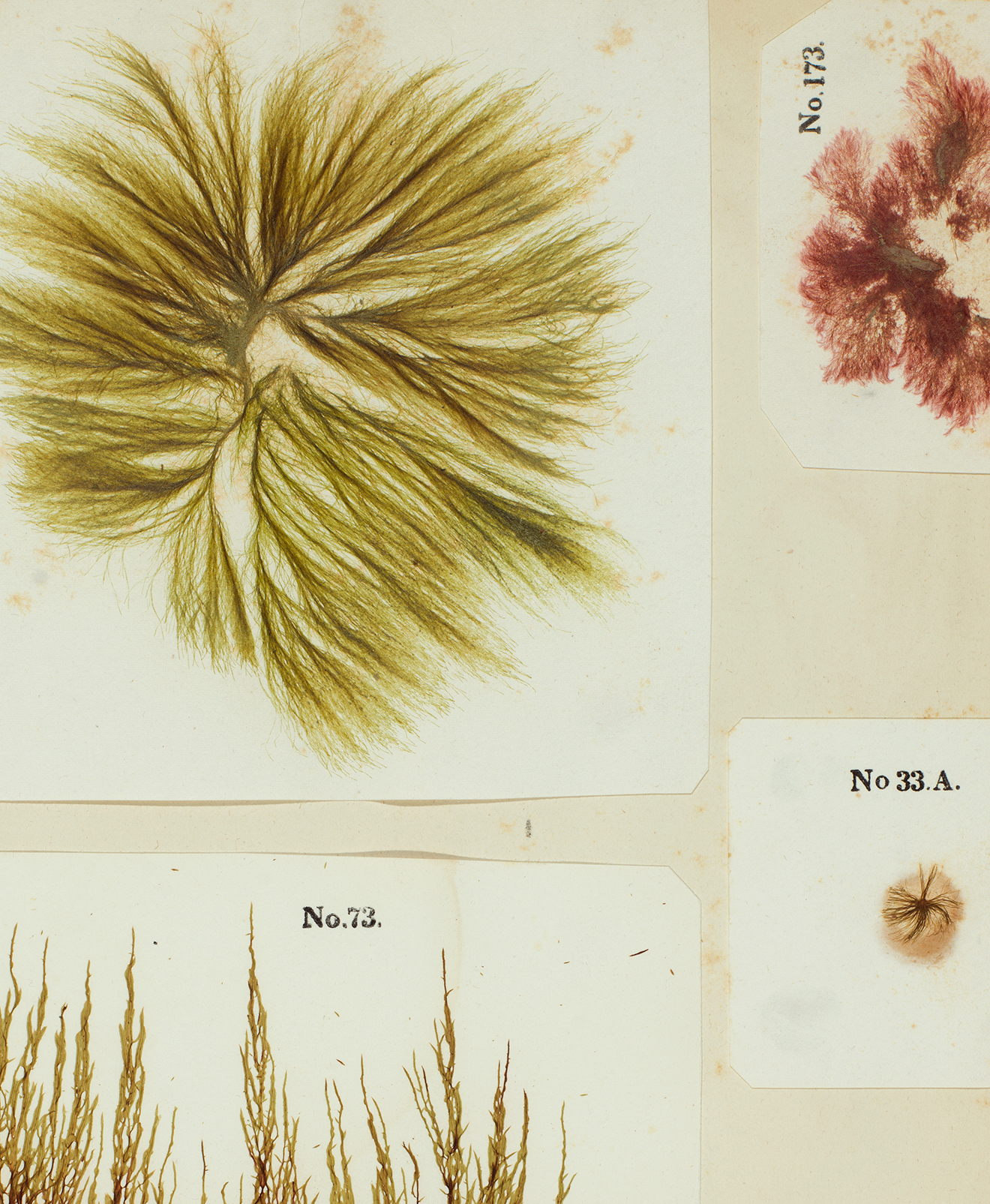
A few of the 293 seaweed specimens in the pages of Algology (1850), by Charles F. Durant. Photograph by Kate Lain.
The documentary Chasing Coral (2017) brings coral close. Using underwater time-lapse photography, the film chronicles the catastrophic effects of global warming on coral reefs. The goal is to get people to feel for coral, and to me it seems impossible that anyone would not be moved by witnessing the transformation of colorful, thriving coral habitats into dead, abandoned, ghostly white husks.
Yet a review of the film in the Telegraph, which largely praises its ingenuity and effectiveness, questions whether any effort could conquer “public indifference to the underwater world.” For who could possibly find coral “adorable,” other than specialists, such as the marine biologists, coral photographers, and other self-proclaimed “coral nerds” who feature in the film? For the rest of us, “the truth is that, close-up, these animal-plant hybrids look weird and icky,” hardly a subject worthy of our affection, let alone the kind of passion required for preservation.
I had this review in mind recently in the Ahmanson Reading Room when a staff member handed over a rare book I had requested, a work by one C. F. Durant, published in New York in 1850, and fancifully titled Algology. The word is stamped in large, gold cursive letters across a red leather binding, and it means, essentially, the collection, preservation, and identification of seaweeds. It was immediately clear to me that this book would not be a book alone: it would be an experience. For C. F. Durant was not indifferent to the underwater world.
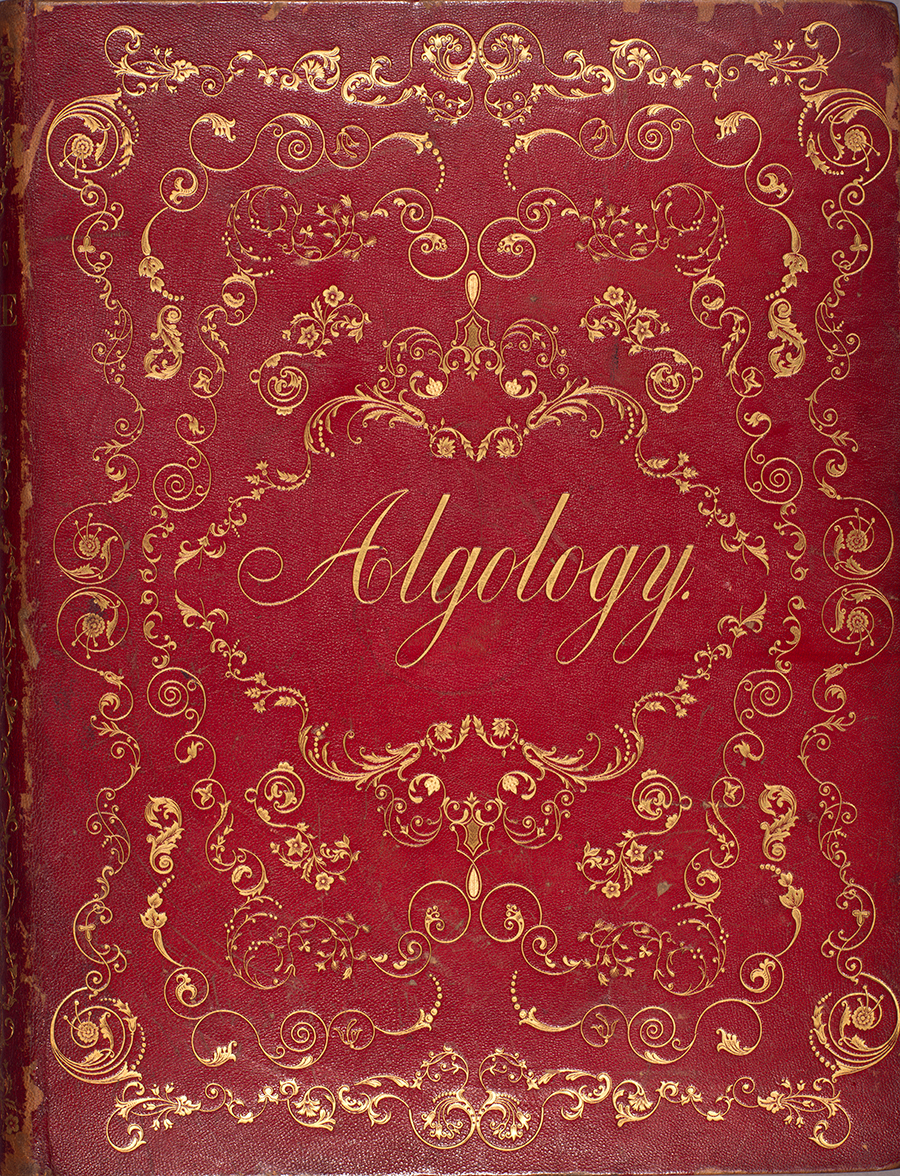
Elaborately bound in red leather, Algology is embossed with gold cursive lettering and gold flourishes that visually echo the shapes of the seaweed specimens mounted in the book.
Charles Ferson Durant (1805–1873) was not a scientist, or any sort of seaweed specialist, but rather a man of wide and varied interests, as I learned by piecing together a variety of scattered sources (there is no comprehensive biography). A Jersey City stockbroker by day, Durant was also a prolific author on many topics. Publication notices for Algology hail Durant as “the first in this country to issue a book on the science of Algology,” but his other work includes a book on animal magnetism, a study of silk production, a guide to hydraulics, and a volume of poetry titled The Aeronaut to the People! (1833). (Apparently, Durant flew hot air balloons on several occasions in New York and Boston during the 1830s, and would toss handfuls of his poems, on the joys of hot air balloon flight, to the crowds below—the aeronaut to the people! He is sometimes hailed as our nation’s first distributor of aerial leaflets.)
In his capacity as “algologist,” however, Durant participated in what was actually a somewhat popular Victorian pastime. Victorians loved seaweed, which they affectionately called “ocean-flowers.” They would gather it from the seaside, and then dry and mount it in the pages of “seaweed albums,” scrapbooks kept as souvenirs or given as gifts. Yet what sets Durant apart from other seaweed enthusiasts is the sheer volume of specimens that he was determined not only to collect and preserve, but also to share with the public. For Algology is not a personal album, but rather a work issued by a well-known New York publishing firm in a print run of 15 copies. And each copy contains no less than 300 specimens.
The book is literally filled with seaweed. Wonderful and strange, in a variety of greens, reds, browns, and purples, branching in all manner of sinuous forms, seaweed—actual seaweed—graces no less than 60 pages of Algology, about five specimens per page. The Huntington’s copy is unusually well-preserved: it contains 293 of the original 300 specimens Durant had included. Some are thick and textured; others are graceful, thin, and fanning; all are completely captivating.
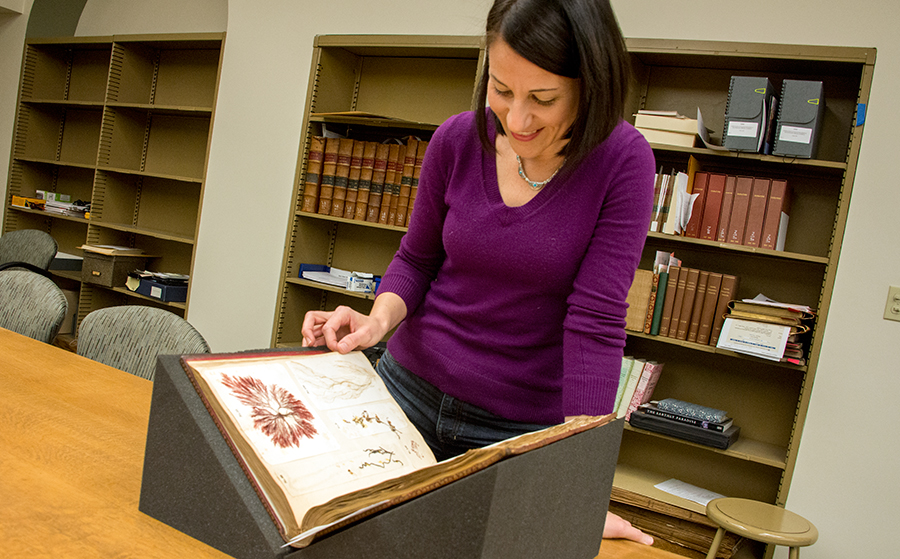
Michele Navakas—assistant professor of English and affiliate of American Studies at Miami University of Ohio, and a 2017–18 National Endowment for the Humanities fellow in residence at The Huntington—examines the astonishing range of seaweed colors and textures in Algology , well preserved more than a century and a half after author Charles F. Durant prepared the volume. Photograph by Kate Lain.
But perhaps the most astonishing fact is that, in order to fulfill his print run, Durant had to have collected, preserved, and mounted no less than 1,500 pieces of seaweed. How—and why—would a Jersey City stockbroker possibly do that?
“For two years,” explains Durant in the preface of Algology, “I lived a sort of amphibious life, paddling about the shallows when the tide was out, in quest of specimens.” On some mornings, he would rise before dawn, walk the 10 minutes from his home to New York Bay, and wade the waters in the early hours, spared from “the business affairs of the day.” On other days, though, Durant would visit more “distant shores of the Bay,” and spend “several hours,” or even “an entire day,” collecting. “The original design was to acquire at least one of each species indigenous to the harbor,” he explains. In size, the harbor’s seaweeds ranged from “microscopic to gigantic growth,” and they came in all colors, though most commonly “olive, red, and green.”
“The pursuit is easy; a delightful recreation,” Durant assures us. Indeed, it is “particularly and invitingly appropriate for ladies,” who have “delicate fingers” and “keen perceptions.” The difficulty comes in identifying what one has collected: “ascertaining the exact position of each plant in the natural order” is especially vexing with algae because algae “of different genera” sometimes look exactly the same, while others of “the same species will seem entirely dissimilar.” And then there is the work of “preparing and drying.” Some specimens are “most delicate,” and thus require immediate attention. Most are “more hardy and tough,” and thus could wait until evening, when Durant would return home to perform “microscopic examinations” by “the light of the candle or lamp” before mounting the specimens on small cards he would number and affix to the pages of his masterwork.
All told, Algology took 2,000 hours of labor, including over 1,000 miles of “perambulations on tidal and sea-shore.” Appropriately, Durant dedicated the book to Neptune. The dedication page features an engraving of the sea god grasping a triton, below which Durant hails him as “the noble scion of Saturn, whose kingdom is the seas, and whose care is the plants and the creatures that live in and upon the waters.” It closes with gratitude from Neptune’s “grateful and obliged servant, The Author, Jersey City, December 1850.”
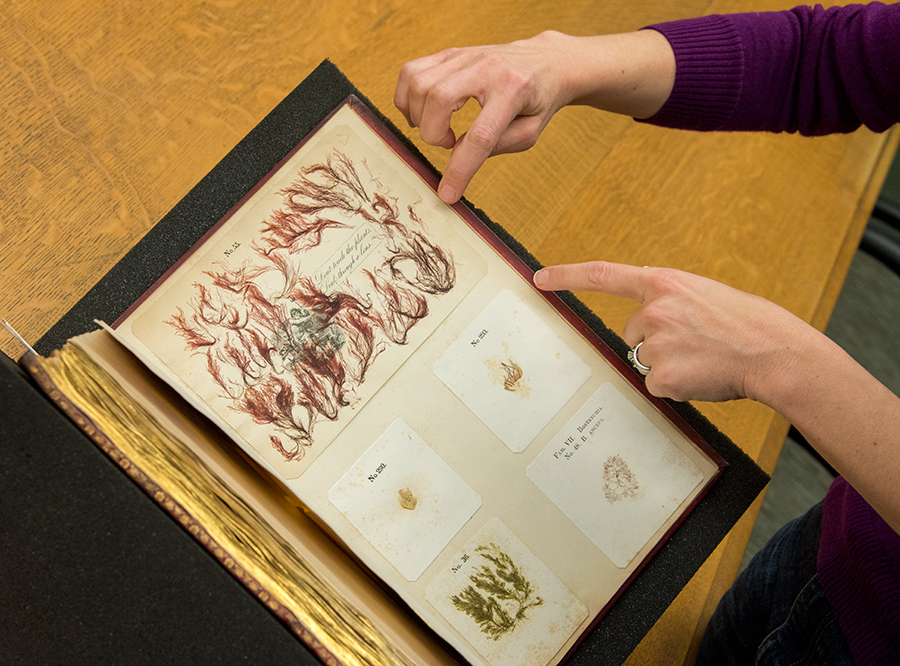
Michele Navakas—assistant professor of English and affiliate of American Studies at Miami University of Ohio, and a 2017–18 National Endowment for the Humanities fellow in residence at The Huntington—examines the astonishing range of seaweed colors and textures in Algology , well preserved more than a century and a half after author Charles F. Durant prepared the volume. Photograph by Kate Lain.
Pondering this page, along with the sheer scope and glory of Algology, I realized that my brief foray into Durant’s life gave me a lifetime of things to think about. Yet I still hadn’t solved the mystery of his motivations: what compels a man to turn into an amphibious algologist? Answering this question required me to do what literary scholars are best at doing: examine the words on the page. Or, in this case, the words and the seaweed on the page.
One of the strangest, most wonderfully illuminating moments in Algology is when Durant describes his realization that seaweed can move. Peering closely through the lens of a microscope, he writes, “the first discovery of this motion produced a sympathetic shock, that caused me to close the eye, and suddenly withdraw it from the microscope; the sensation was akin to that experienced when unexpectedly witnessing the accidental maiming or killing a fellow-creature.” Why did the motion of seaweed generate this response? Because Durant thought the plants’ motions may have been “caused by pain,” and that, having been “several hours out of their element,” they may even “have felt the agonies of death.” The motions suggested to Durant that seaweed was not a mere plant, but rather an animal—one that could feel as humans could.
One purpose of the book, then, is to draw attention to the motions of seaweed, and to the resulting taxonomic question of whether seaweed is truly a vegetable after all. The prospect exhilarated Durant: it could upend the system of classification instituted by Linnaeus, the great Enlightenment taxonomist. Linnaeus had long ago identified seaweed as a vegetable, yet Linnaeus resided “at a great distance from the sea,” explains Durant, and thus he never saw seaweed in its “natural element.” For, if he had, he probably would have “[hesitated] before severing the link with which Nature binds both Algae and Corallines to animal life.”
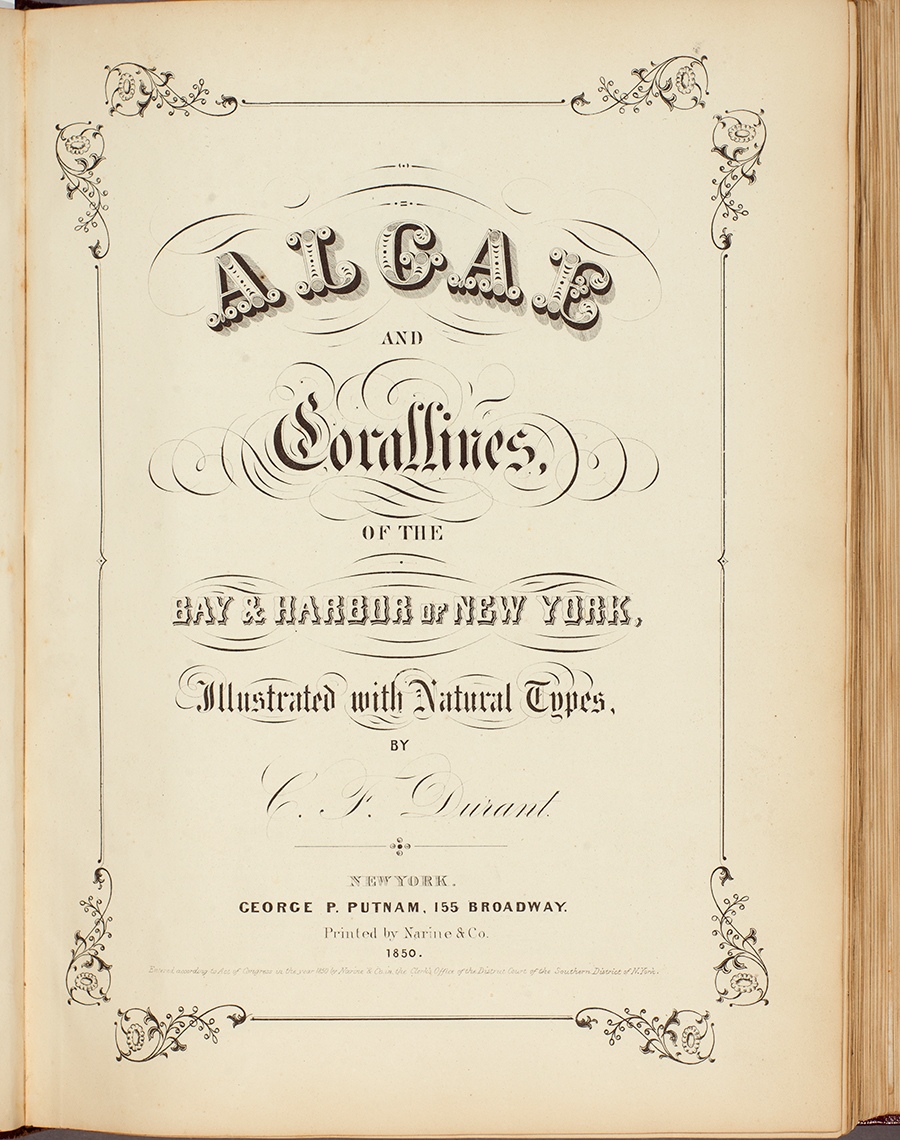
Durant’s decorative title page for Algology bears the text’s official title, Algae and Corallines, of the Bay & Harbor of New York. Illustrated with Natural Types. Victorians were fascinated by seaweed and enjoyed collecting it in “seaweed albums.” What makes Durant unique is that he published his seaweed album with a major New York firm, which printed at least 15 copies of the book.
The motions of seaweed moved plant and animal closer together along the taxonomic chain, but they also mattered for another reason. When conducting his nightly “microscopic examinations,” Durant sometimes felt that looking closely at algae was like peering at “an unfathomable abyss, too wide, too deep, too vast for perfect exploration by human eye, or intellectual vision.” Seaweed confronted him with the limits of human perception itself. It told him how much he did not know—and perhaps could not know—of the natural world. This is the lesson we risk missing if we never look closely at seaweed, and it compelled Durant to wade the shallows of Jersey City for two years, and over a thousand miles: he wanted to bring seaweed close, and share the humbling shock of knowing the natural world’s unfathomable complexity.
So, then, what can we learn from these encounters—Durant’s, with the underwater world; ours, with his book full of seaweed?
When you do take the time to look closely at the seaweed in Algology, you know pretty quickly that there are no words to fully describe them in all of their surprising color, manifold shapes and textures, and minute details. And this is exactly the point. As Durant explains, if one is to know seaweed, then “[l]anguage alone is inadequate.” One must also observe it alive in its “native element” and peer closely, and often, at “natural (not painted)” types. Only from the combination of words, living examples, and natural specimens can knowledge of seaweed emerge—along with the stunning realizations about ourselves and the world that we gain from attending to the smallest, most submerged, and apparently unimportant forms of life.
First and foremost, then, Algology teaches us that some things just cannot be digitized. Digital databases of early printed works and manuscripts are critical because they dramatically expand scholarly and public access to the words on the pages of books that may otherwise remain hidden away in libraries or other cultural institutions. Yet, in many cases, words alone yield only partial or inaccurate knowledge. Sometimes we require the thing itself.
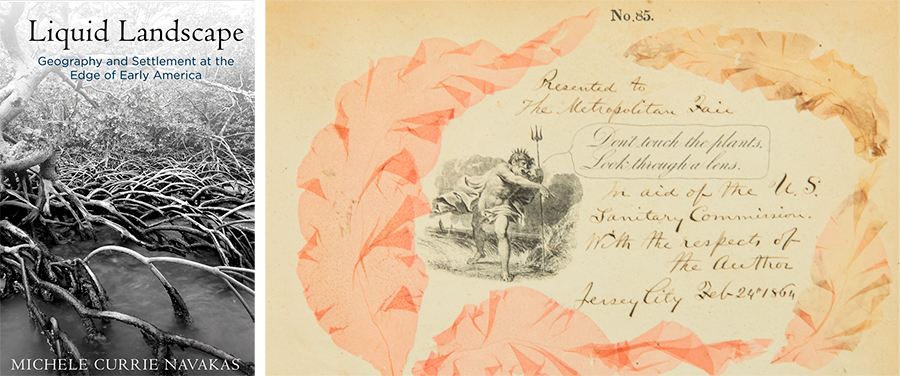
Left: In her first book, Liquid Landscape: Geography and Settlement at the Edge of Early America (University of Pennsylvania Press, 2018), Michele Navakas analyzes the history of Florida’s incorporation alongside the development of new ideas of personhood, possession, and political identity. Reading a vast archive of texts spanning Revolution to Reconstruction, Navakas uncovers an alternative history of American possession not descended from conceptions of American land as enduring, solid, and divisible. Right: Nestled among the 293 seaweed specimens in Algology is a placard with an engraving of Neptune, who warns readers, “Don’t touch the plants. Look through a lens.” Durant must have pasted this placard in the book to preserve the samples from the hands of eager readers. The placard also identifies The Huntington’s copy of the book as a gift “Presented to the Metropolitan Fair in aid of the U.S. Sanitary Commission. With the respects of the author. Jersey City Feb 24, 1864.”
Second, Algology shows how much we need not only archives, but also places that bring together specialists trained in the collection, preservation, and interpretation of rare materials. I regularly rely on the interdisciplinary collaboration that The Huntington fosters, combining my training in literary analysis with the expertise of curatorial staff in rare books and the history of science. Some kinds of knowledge emerge only from the combination of language and seaweed, paper and binding, curator and literary scholar.
Finally, Algology tells us that “public indifference to the underwater world,” though widespread today, is neither natural nor inevitable. There was a time in this country when studying the sub-aqueous was popular, no matter one’s day job—a time when coral, seaweed, and other submerged life forms were not “weird and icky” to all but specialists. Readers of Algology felt deeply for seaweed, and they wanted to reach out and literally feel the specimens. Durant anticipated this, admonishing readers not to do so to protect the specimens. “Don’t touch the plants. Look through a lens,” warns a tiny figure of Neptune that Durant placed among the specimen placards (see image above). Indeed, “[t]he crowning beauty of Algology is…the plants themselves,” raved one 19th-century reviewer of the book.
We need a book full of seaweed now more than ever. The U.S. is one of the world’s five most significant emitters of carbon dioxide. If this is partly because we care only for parts of nature that we regularly see, then we need to see more seaweed. We need, in other words, to learn to feel for the underwater world from those who were better at it than we are.
Michele Navakas is assistant professor of English and affiliate of American Studies at Miami University of Ohio, and a 2017–18 National Endowment for the Humanities fellow in residence at The Huntington. Her first book, Liquid Landscape: Geography and Settlement at the Edge of Early America, was published this year by University of Pennsylvania Press. She is currently at work on her second book, a cultural history of coral in early America.